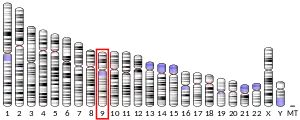Protein transport protein Sec61 subunit beta is a protein that in humans is encoded by the SEC61B gene.[5][6][7]
The Sec61 complex is the central component of the protein translocation apparatus of the endoplasmic reticulum (ER) membrane. The Sec61 complex forms a transmembrane channel where proteins are translocated across and integrated into the ER membrane. This complex consists of three membrane proteins- alpha, beta, and gamma. This gene encodes the beta-subunit protein. The Sec61 subunits are also observed in the post-ER compartment, suggesting that these proteins can escape the ER and recycle back. There is evidence for multiple polyadenylated sites for this transcript.[7]
References
- 1 2 3 GRCh38: Ensembl release 89: ENSG00000106803 - Ensembl, May 2017
- 1 2 3 GRCm38: Ensembl release 89: ENSMUSG00000053317 - Ensembl, May 2017
- ↑ "Human PubMed Reference:". National Center for Biotechnology Information, U.S. National Library of Medicine.
- ↑ "Mouse PubMed Reference:". National Center for Biotechnology Information, U.S. National Library of Medicine.
- ↑ Hartmann E, Sommer T, Prehn S, Gorlich D, Jentsch S, Rapoport TA (Mar 1994). "Evolutionary conservation of components of the protein translocation complex". Nature. 367 (6464): 654–7. Bibcode:1994Natur.367..654H. doi:10.1038/367654a0. PMID 8107851. S2CID 4323463.
- ↑ Greenfield JJ, High S (Aug 1999). "The Sec61 complex is located in both the ER and the ER-Golgi intermediate compartment". J Cell Sci. 112 (10): 1477–86. doi:10.1242/jcs.112.10.1477. PMID 10212142.
- 1 2 "Entrez Gene: SEC61B Sec61 beta subunit".
Further reading
- Maruyama K, Sugano S (1994). "Oligo-capping: a simple method to replace the cap structure of eukaryotic mRNAs with oligoribonucleotides". Gene. 138 (1–2): 171–4. doi:10.1016/0378-1119(94)90802-8. PMID 8125298.
- Wiertz EJ, Tortorella D, Bogyo M, et al. (1997). "Sec61-mediated transfer of a membrane protein from the endoplasmic reticulum to the proteasome for destruction". Nature. 384 (6608): 432–8. doi:10.1038/384432a0. PMID 8945469. S2CID 6276718.
- Suzuki Y, Yoshitomo-Nakagawa K, Maruyama K, et al. (1997). "Construction and characterization of a full length-enriched and a 5'-end-enriched cDNA library". Gene. 200 (1–2): 149–56. doi:10.1016/S0378-1119(97)00411-3. PMID 9373149.
- Knight BC, High S (1998). "Membrane integration of Sec61alpha: a core component of the endoplasmic reticulum translocation complex". Biochem. J. 331 (Pt 1): 161–7. doi:10.1042/bj3310161. PMC 1219334. PMID 9512475.
- Chen Y, Le Cahérec F, Chuck SL (1998). "Calnexin and other factors that alter translocation affect the rapid binding of ubiquitin to apoB in the Sec61 complex". J. Biol. Chem. 273 (19): 11887–94. doi:10.1074/jbc.273.19.11887. PMID 9565615.
- Kalies KU, Rapoport TA, Hartmann E (1998). "The β Subunit of the Sec61 Complex Facilitates Cotranslational Protein Transport and Interacts with the Signal Peptidase during Translocation". J. Cell Biol. 141 (4): 887–94. doi:10.1083/jcb.141.4.887. PMC 2132780. PMID 9585408.
- Bebök Z, Mazzochi C, King SA, et al. (1998). "The mechanism underlying cystic fibrosis transmembrane conductance regulator transport from the endoplasmic reticulum to the proteasome includes Sec61beta and a cytosolic, deglycosylated intermediary". J. Biol. Chem. 273 (45): 29873–8. doi:10.1074/jbc.273.45.29873. PMID 9792704.
- Ingley E, Williams JH, Walker CE, et al. (1999). "A novel ADP-ribosylation like factor (ARL-6), interacts with the protein-conducting channel SEC61beta subunit". FEBS Lett. 459 (1): 69–74. doi:10.1016/S0014-5793(99)01188-6. PMID 10508919. S2CID 30948975.
- Yamaguchi A, Hori O, Stern DM, et al. (2000). "Stress-Associated Endoplasmic Reticulum Protein 1 (Serp1)/Ribosome-Associated Membrane Protein 4 (Ramp4) Stabilizes Membrane Proteins during Stress and Facilitates Subsequent Glycosylation". J. Cell Biol. 147 (6): 1195–204. doi:10.1083/jcb.147.6.1195. PMC 2168098. PMID 10601334.
- Meyer HA, Grau H, Kraft R, et al. (2000). "Mammalian Sec61 is associated with Sec62 and Sec63". J. Biol. Chem. 275 (19): 14550–7. doi:10.1074/jbc.275.19.14550. PMID 10799540.
- Strausberg RL, Feingold EA, Grouse LH, et al. (2003). "Generation and initial analysis of more than 15,000 full-length human and mouse cDNA sequences". Proc. Natl. Acad. Sci. U.S.A. 99 (26): 16899–903. Bibcode:2002PNAS...9916899M. doi:10.1073/pnas.242603899. PMC 139241. PMID 12477932.
- Humphray SJ, Oliver K, Hunt AR, et al. (2004). "DNA sequence and analysis of human chromosome 9". Nature. 429 (6990): 369–74. Bibcode:2004Natur.429..369H. doi:10.1038/nature02465. PMC 2734081. PMID 15164053.
- Gerhard DS, Wagner L, Feingold EA, et al. (2004). "The Status, Quality, and Expansion of the NIH Full-Length cDNA Project: The Mammalian Gene Collection (MGC)". Genome Res. 14 (10B): 2121–7. doi:10.1101/gr.2596504. PMC 528928. PMID 15489334.
- Besemer J, Harant H, Wang S, et al. (2005). "Selective inhibition of cotranslational translocation of vascular cell adhesion molecule 1". Nature. 436 (7048): 290–3. Bibcode:2005Natur.436..290B. doi:10.1038/nature03670. PMID 16015337. S2CID 4431610.
- Kim JE, Tannenbaum SR, White FM (2005). "Global phosphoproteome of HT-29 human colon adenocarcinoma cells". J. Proteome Res. 4 (4): 1339–46. doi:10.1021/pr050048h. PMID 16083285.
- Olsen JV, Blagoev B, Gnad F, et al. (2006). "Global, in vivo, and site-specific phosphorylation dynamics in signaling networks". Cell. 127 (3): 635–48. doi:10.1016/j.cell.2006.09.026. PMID 17081983. S2CID 7827573.
- Liao HJ, Carpenter G (2007). "Role of the Sec61 Translocon in EGF Receptor Trafficking to the Nucleus and Gene Expression". Mol. Biol. Cell. 18 (3): 1064–72. doi:10.1091/mbc.E06-09-0802. PMC 1805100. PMID 17215517.
This article is issued from Wikipedia. The text is licensed under Creative Commons - Attribution - Sharealike. Additional terms may apply for the media files.




